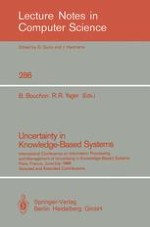1987 | Buch
Uncertainty in Knowledge-Based Systems
International Conference on Information Processing and Management of Uncertainty in Knowledge-Based Systems Paris, France, June 30 – July 4, 1986 Selected and Extended Contributions
herausgegeben von: B. Bouchon, R. R. Yager
Verlag: Springer Berlin Heidelberg
Buchreihe : Lecture Notes in Computer Science
Enthalten in: Professional Book Archive
